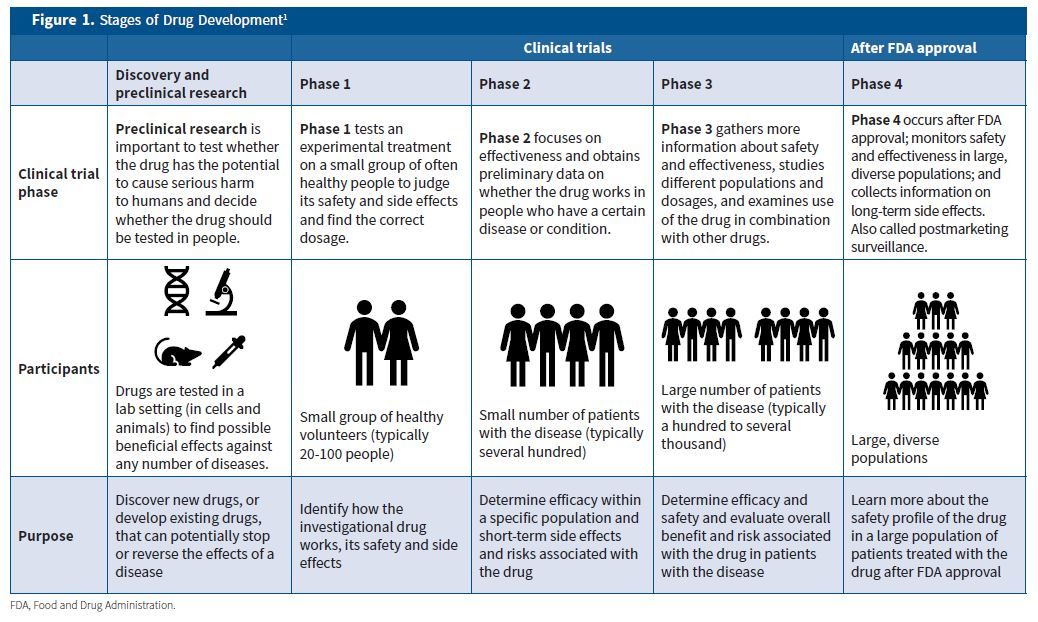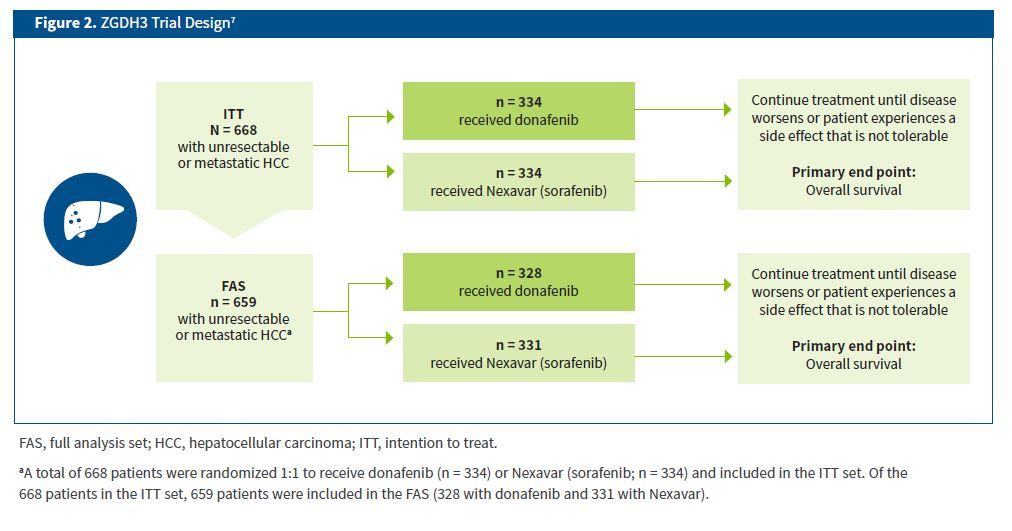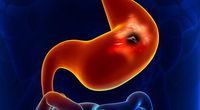Article
ASCO 2020: Results from the Phase 2/3 ZGDH3 Trial
The Educated Patient®: Research Updates provides current clinical updates for different disease states. The following information is for educational purposes and is not medical advice.
FOR YOUR REFERENCE: What Are Clinical Trials?
Clinical trials determine whether a drug works in humans and if it is safe and effective. To find out whether a drug can be approved for use, the Food and Drug Administration (FDA) requires four phases of a clinical trial. The number of participants increases in each phase, starting from 20 to
80 people for a phase 1 trial to up to 3,000 for a phase 3 trial (Figure 1).1
- Phase 1: tests an experimental treatment on a small group of often healthy people to judge its safety and side effects and find the correct dosage.
- Phase 2: focuses on effectiveness and obtains preliminary data on whether the drug works in people who have a certain disease or condition.
- Phase 3: gathers more information about safety and effectiveness, studies different populations and dosages, and examines use of the drug in combination with other drugs.
- Phase 4: occurs after FDA approval; monitors safety and effectiveness in large, diverse populations; and collects information on long-term side effects.

FOR YOUR REFERENCE: What Is Hepatocellular Carcinoma?
Hepatocellular carcinoma (HCC) is the most common primary liver cancer in adults.2 Chronic infection with hepatitis B virus (HBV) or hepatitis C virus (HCV) is the most common risk factor for HCC worldwide.3 In the United States, HCV is often the cause of HCC, whereas HBV is the more common cause of HCC in Asia and developing countries.3 These infections lead to cirrhosis of the liver and are responsible for making liver cancer the most common cancer in many parts of the world. Heavy alcohol use (a leading cause of cirrhosis in the United States), tobacco use and obesity are also associated with an increased risk of liver cancer.3
People with HCC may experience symptoms such as unintentional weight loss, loss of appetite, fullness after a small meal, nausea or vomiting, pain and/or swelling in the belly, itching and jaundice. When liver cancer is suspected after a physical examination, further tests including imaging tests, lab tests and/or biopsies of liver tissue are performed.4
A small number of people have early-stage HCC with an otherwise healthy liver and may be cured with a surgery (partial hepatectomy). For those with early-stage HCC whose liver is not otherwise healthy, treatment options include a liver transplant, ablation or embolization, which is given to control the cancer pretransplant.5
For inoperable (unresectable) HCC that has not spread to lymph nodes or other sites, treatment options include5:
- Ablation, embolization or both.
- Chemotherapy, immunotherapy, radiation therapy, targeted therapy and clinical trials.
- Partial hepatectomy if treatment shrinks the tumor sufficiently.
For recurrent HCC, treatment options include5:
- Further surgery, or ablation and/or embolization
(for resectable disease). - Chemotherapy, immunotherapy, targeted therapy, clinical
trials and treatment to relieve pain and other side effects
(for metastatic disease).
For advanced (metastatic) HCC, treatment options include immunotherapy, targeted therapy and clinical trials.5
FOR YOUR REFERENCE: What Medications Were Investigated in the ZGDH3 Trial?
Nexavar (sorafenib) is an FDA-approved drug indicated for treating unresectable HCC6 and shows promise as a potential first-line therapy for advanced HCC.7 Donafenib is a novel drug that was found to be safe and effective in previous phase 1a and 1b studies.7,8 Both Nexavar and donafenib are multikinase inhibitors.7,8 Kinases are a type of enzyme (a protein that speeds up chemical reactions in the body) that adds chemicals to other molecules in a cell that may cause them to become either active or inactive. Multikinase inhibitors are a substance that blocks more than one kinase enzyme from its function, such as cell signaling, metabolism, division and survival. In certain cancer cells with more active kinases, blocking them may help keep the cancer cells from growing, a mechanism that is often used in cancer treatment.9
ASCO 2020: Phase 2/3 ZGDH3 Trial
The phase 2/3 trial included patients with unresectable or metastatic HCC, one or more lesions, a Child-Pugh liver function score of seven or less, an Eastern Cooperative Oncology Group performance score of 0-1 and no prior systemic therapy. In this study, 668 patients enrolled from 37 sites across China were randomly assigned to receive either donafenib (334 patients) or Nexavar (334 patients) until severe toxicity, intolerance or disease progression (when their disease continued to worsen) (Figure 2).7 All patients were included in the intention-to-treat (ITT) set (n = 668). The primary end point of the trial was overall survival (OS). Efficacy analysis was based primarily on a full analysis set of 659 patients (328 on donafenib and 331 on Nexavar).7

Results
In the full analysis set, the median OS was 12.1 months in the donafenib group compared with 10.3 months in the Nexavar group (Figure 3).7 Similarly, in the ITT set, the median OS was 12.0 months with donafenib and 10.1 months with Nexavar. No significant differences in median progression-free survival, objective response rate or disease control rate were observed with either drug.7

Grade 3 or higher side effects occurred less frequently in the donafenib group (57%) compared with the Nexavar group (67%). Common grade 3 or higher treatment-related side effects that occurred in patients treated with donafenib and Nevaxar, respectively, included hand-foot skin reaction (6% and 12%), decreased platelet count (4% and 2%), hypophosphatemia (3% and 5%), hypertension (9% and 9%), and elevated aspartate aminotransferase (2% and 5%).7
Investigators concluded that donafenib significantly improved OS over Nexavar with favorable safety and tolerability and shows promise as a first-line treatment option for patients with advanced HCC.7
Not all patients qualify for certain clinical trials. If you are interested in enrolling in a trial, talk with your doctor about which treatment options would be most appropriate for you.
FOR YOUR REFERENCE: Glossary of Terms
Ablation: a procedure to shrink a liver tumor by sending radio waves, chemicals, heat or cold into the tumor
Aspartate aminotransferase: an enzyme found mostly in the liver but also in muscles. When the liver is damaged, it releases aspartate aminotransferase into the bloodstream, translating to elevated/higher levels when tested and indicating that there is an underlying problem.
Bilirubin: a yellowish substance made during the body’s normal process of breaking down red blood cells. A healthy liver should remove most of the bilirubin from the body. If the liver is damaged, bilirubin leaks out and gets into the blood.
Biopsy: a procedure that removes a piece of tissue or a sample of cells from the body for analysis
Child-Pugh liver function score: a scoring system designed to predict mortality in patients with cirrhosis
Chemotherapy: treatment that uses drugs to stop the growth of cancer cells by either killing the cells or stopping them from dividing. These drugs are taken by mouth or injected through IV infusion and enter the bloodstream so they can help fight cancers that spread throughout the body. This can affect cancer cells and normal cells.
Chronic disease: a disease or condition that lasts for 3 months or longer and may get worse over time
Cirrhosis: a disease in which liver cells become damaged and are replaced by scar tissue
Disease control rate: percentage of patients whose disease partially or completely shrinks or remains stable over a certain time period
Efficacy: the ability to produce a desired outcome. In the case of cancer treatments, the desired outcome is a decrease in the number of cancer cells or the disappearance of cancer cells.
Embolization therapy: delivers chemotherapy drugs or tiny glass spheres containing radiation directly to cancer cells
End point: the outcome researchers want to study in a clinical trial to determine if the intervention is beneficial
First-line therapy: the first treatment given for a disease
Full analysis set (FAS): in a clinical trial, a set of participants that is defined by starting with all those who were randomized and then deleting participants for specific reasons, such as violating study protocol or not having received any study medication
Hand-foot skin reaction: a side effect of some cancer treatments involving redness, swelling and pain on the palms of the hands and/or soles of the feet
Hepatectomy: a surgery to remove all or part of the liver
Hepatitis B: a vaccine-preventable liver infection caused by the hepatitis B virus; spread through contact with blood, semen or other body fluids from an infected person
Hepatitis C: a liver infection caused by the hepatitis C virus and spread through contact with blood from an infected person. There is no vaccine to prevent the spread.
Immunotherapy: type of therapy that uses substances to stimulate or suppress the immune system to help the body fight cancer, infection and other diseases. Some types of immunotherapy only target certain cells of the immune system; others affect the immune system in a general way.
Intention to treat (ITT): analysis of the results of an clinical study, based on the initial treatment assignment and not on the treatment eventually received
Jaundice: a condition in which the skin and the whites of the eyes become yellow, urine darkens, and the color of stool becomes lighter than normal; occurs when the liver is not working properly or a bile duct is blocked
Kinase: a type of enzyme (a protein that speeds up chemical reactions in the body) that adds chemicals to other molecules in that cell that may cause them to become either active or inactive
Liver transplant surgery: surgery to remove the entire liver and replace it with a liver from a donor; may be an option for otherwise healthy people whose cancer has not spread beyond the liver
Lymph node: part of the lymphatic system in the body’s immune system that circulates fluid containing white blood cells, which help fight infections and diseases
Metastatic: cancer that has spread from the primary site to other parts of the body
Multikinase inhibitors: a substance that blocks more than one kinase enzyme from its function, such as cell signaling, metabolism, division and survival. In certain cancer cells with more active kinases, blocking them may help keep the cancer cells from growing, a tactic often used in cancer treatment.
Objective response rate: a specific percentage of patients who responded to treatment and their tumors completely or partially shrunk (complete response or partial response)
Overall survival (OS): the length of time from either the date of diagnosis or the start of treatment for a disease that a patient is still alive
Pharmacokinetics: passage of drugs into, through and out of the body. The drug passes through four phases: absorption, distribution, metabolism and excretion.
Platelet count: a lab test that measures the average number of platelets in the blood, which promote wound healing and prevent excessive bleeding
Primary end point: the main result that is measured at the end of
a study to see if a given treatment worked
Primary hepatocellular cancer: cancer that starts in the liver
Progression-free survival: the length of time during and after the treatment of a disease that a patient lives with the disease but it does not get worse
Radiation therapy: type of cancer treatment that uses beams of intense energy to kill cancer cells
Recurrent: cancer that has come back to the same place or another place in the body after a period of time when the cancer was not detected
Resectable: a tumor that can be removed with surgery
Side effect: any unfavorable or unintended disease, sign or symptom that occurs during the time a patient is receiving a medical treatment or procedure
Systemic therapy: any type of cancer treatment that targets the entire body
Targeted therapy: a cancer treatment that uses drugs to target specific aspects of the cancer cells
Toxicity: the extent to which something is poisonous or harmful
Unresectable: not removable with surgery
References
- What are clinical trials and studies? National Institute on Aging. Accessed May 13, 2021. https://www.nia.nih.gov/health/what-are-clinical-trials-and-studies
- About liver cancer. American Cancer Society. Updated April 1, 2019. Accessed May 11, 2021. https://www.cancer.org/content/dam/CRC/PDF/Public/8698.00.pdf
- Liver cancer causes, risk factors, and prevention. American Cancer Society. Updated April 1, 2019. Accessed May 11, 2021. https://www.cancer.org/content/dam/CRC/PDF/Public/8700.00.pdf
- Liver cancer early detection, diagnosis, and staging. American Cancer Society. Updated April 1, 2021. Accessed May 11, 2021. https://www.cancer.org/content/dam/CRC/PDF/Public/8700.00.pdf
- Treatment of liver cancer, by stage. American Cancer Society. Updated June 10, 2020. Accessed May 19, 2021. https://www.cancer.org/cancer/liver-cancer/treating/by-stage.html
- Nexavar prescribing information. Bayer HealthCare Pharmaceuticals Inc; 2020. Accessed May 11, 2021. https://www.accessdata.fda.gov/drugsatfda_docs/label/2020/021923s023lbl.pdf
- Qin S, Bi F, Gu S, et al. Donafenib versus sorafenib in first-line treatment of unresectable or metastatic hepatocellular carcinoma: a randomized, open-label, parallel-controlled phase II-III trial. J Clin Oncol. Published online June 29, 2021.doi:10.1200/JCO.21.00163
- Liu J, Li X, Zhang H, et al. Safety, pharmacokinetics and efficacy of donafenib in treating advanced hepatocellular carcinoma: report from a phase 1b trial. Pharmazie. 2019;74(11):688-693. doi:10.1691/ph.2019.9626
- Treating liver cancer. American Cancer Society. Updated June 10, 2020. Accessed May 13, 2021. https://www.cancer.org/content/dam/CRC/PDF/Public/8701.00.pdf





